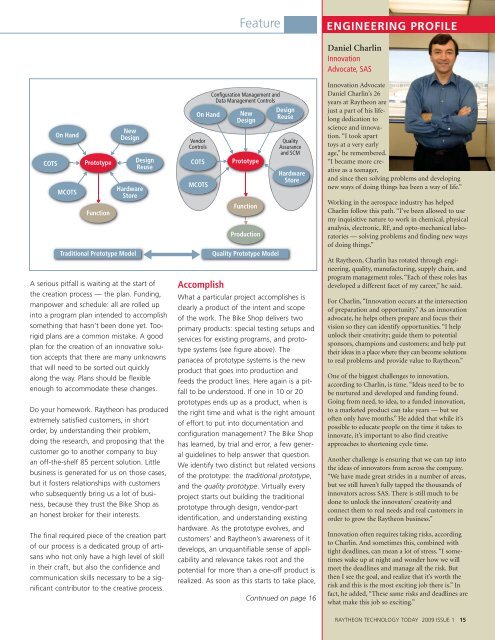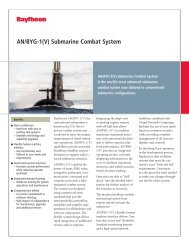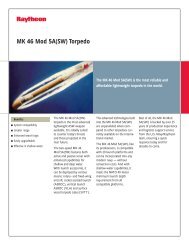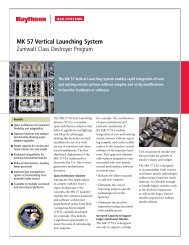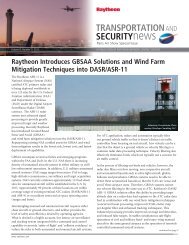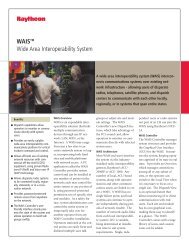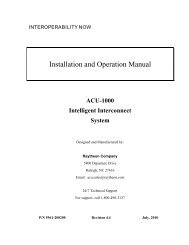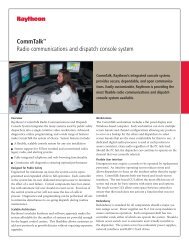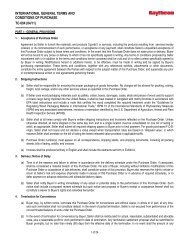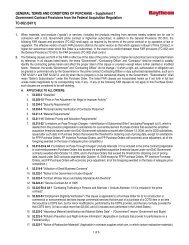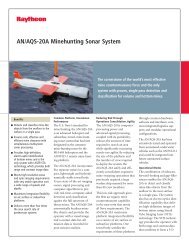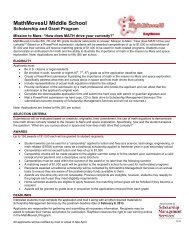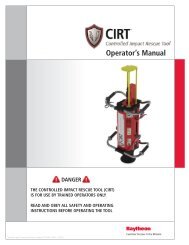Tech_Issue 1 2009_0127_Final:TechToday_012709 ... - Raytheon
Tech_Issue 1 2009_0127_Final:TechToday_012709 ... - Raytheon
Tech_Issue 1 2009_0127_Final:TechToday_012709 ... - Raytheon
Create successful ePaper yourself
Turn your PDF publications into a flip-book with our unique Google optimized e-Paper software.
COTS<br />
On Hand<br />
MCOTS<br />
Prototype<br />
Function<br />
New<br />
Design<br />
Hardware<br />
Store<br />
Design<br />
Reuse<br />
A serious pitfall is waiting at the start of<br />
the creation process — the plan. Funding,<br />
manpower and schedule: all are rolled up<br />
into a program plan intended to accomplish<br />
something that hasn’t been done yet. Toorigid<br />
plans are a common mistake. A good<br />
plan for the creation of an innovative solution<br />
accepts that there are many unknowns<br />
that will need to be sorted out quickly<br />
along the way. Plans should be flexible<br />
enough to accommodate these changes.<br />
Do your homework. <strong>Raytheon</strong> has produced<br />
extremely satisfied customers, in short<br />
order, by understanding their problem,<br />
doing the research, and proposing that the<br />
customer go to another company to buy<br />
an off-the-shelf 85 percent solution. Little<br />
business is generated for us on those cases,<br />
but it fosters relationships with customers<br />
who subsequently bring us a lot of business,<br />
because they trust the Bike Shop as<br />
an honest broker for their interests.<br />
The final required piece of the creation part<br />
of our process is a dedicated group of artisans<br />
who not only have a high level of skill<br />
in their craft, but also the confidence and<br />
communication skills necessary to be a significant<br />
contributor to the creative process.<br />
On Hand<br />
Vendor<br />
Controls<br />
COTS<br />
MCOTS<br />
Accomplish<br />
Feature<br />
Configuration Management and<br />
Data Management Controls<br />
New<br />
Design<br />
Prototype<br />
Function<br />
Production<br />
Traditional Prototype Model Quality Prototype Model<br />
Design<br />
Reuse<br />
Quality<br />
Assurance<br />
and SCM<br />
Hardware<br />
Store<br />
What a particular project accomplishes is<br />
clearly a product of the intent and scope<br />
of the work. The Bike Shop delivers two<br />
primary products: special testing setups and<br />
services for existing programs, and prototype<br />
systems (see figure above). The<br />
panacea of prototype systems is the new<br />
product that goes into production and<br />
feeds the product lines. Here again is a pitfall<br />
to be understood. If one in 10 or 20<br />
prototypes ends up as a product, when is<br />
the right time and what is the right amount<br />
of effort to put into documentation and<br />
configuration management? The Bike Shop<br />
has learned, by trial and error, a few general<br />
guidelines to help answer that question.<br />
We identify two distinct but related versions<br />
of the prototype: the traditional prototype,<br />
and the quality prototype. Virtually every<br />
project starts out building the traditional<br />
prototype through design, vendor-part<br />
identification, and understanding existing<br />
hardware. As the prototype evolves, and<br />
customers’ and <strong>Raytheon</strong>’s awareness of it<br />
develops, an unquantifiable sense of applicability<br />
and relevance takes root and the<br />
potential for more than a one-off product is<br />
realized. As soon as this starts to take place,<br />
Continued on page 16<br />
ENGINEERING PROFILE<br />
Daniel Charlin<br />
Innovation<br />
Advocate, SAS<br />
Innovation Advocate<br />
Daniel Charlin’s 26<br />
years at <strong>Raytheon</strong> are<br />
just a part of his lifelong<br />
dedication to<br />
science and innovation.<br />
“I took apart<br />
toys at a very early<br />
age,” he remembered.<br />
“I became more creative<br />
as a teenager,<br />
and since then solving problems and developing<br />
new ways of doing things has been a way of life.”<br />
Working in the aerospace industry has helped<br />
Charlin follow this path. “I’ve been allowed to use<br />
my inquisitive nature to work in chemical, physical<br />
analysis, electronic, RF, and opto-mechanical laboratories<br />
— solving problems and finding new ways<br />
of doing things.”<br />
At <strong>Raytheon</strong>, Charlin has rotated through engineering,<br />
quality, manufacturing, supply chain, and<br />
program management roles. “Each of these roles has<br />
developed a different facet of my career,” he said.<br />
For Charlin, “Innovation occurs at the intersection<br />
of preparation and opportunity.” As an innovation<br />
advocate, he helps others prepare and focus their<br />
vision so they can identify opportunities. “I help<br />
unlock their creativity; guide them to potential<br />
sponsors, champions and customers; and help put<br />
their ideas in a place where they can become solutions<br />
to real problems and provide value to <strong>Raytheon</strong>.”<br />
One of the biggest challenges to innovation,<br />
according to Charlin, is time. “Ideas need to be to<br />
be nurtured and developed and funding found.<br />
Going from need, to idea, to a funded innovation,<br />
to a marketed product can take years — but we<br />
often only have months.” He added that while it’s<br />
possible to educate people on the time it takes to<br />
innovate, it’s important to also find creative<br />
approaches to shortening cycle time.<br />
Another challenge is ensuring that we can tap into<br />
the ideas of innovators from across the company.<br />
“We have made great strides in a number of areas,<br />
but we still haven’t fully tapped the thousands of<br />
innovators across SAS. There is still much to be<br />
done to unlock the innovators’ creativity and<br />
connect them to real needs and real customers in<br />
order to grow the <strong>Raytheon</strong> business.”<br />
Innovation often requires taking risks, according<br />
to Charlin. And sometimes this, combined with<br />
tight deadlines, can mean a lot of stress. “I sometimes<br />
wake up at night and wonder how we will<br />
meet the deadlines and manage all the risk. But<br />
then I see the goal, and realize that it’s worth the<br />
risk and this is the most exciting job there is.” In<br />
fact, he added, “These same risks and deadlines are<br />
what make this job so exciting.”<br />
RAYTHEON TECHNOLOGY TODAY <strong>2009</strong> ISSUE 1 15


